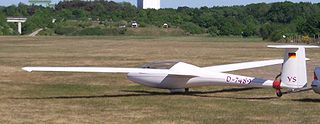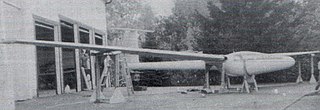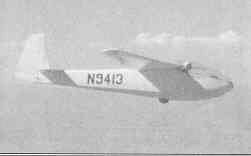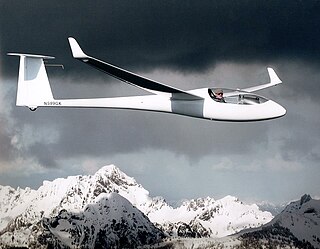
The Standard Cirrus is a German Standard-class glider built by Schempp-Hirth. The Standard Cirrus was produced between 1969 and 1985, when it was replaced by the Discus. Over 800 examples were built, making it one of the most successful early fibreglass glider designs.

The Schempp-Hirth Cirrus is an Open Class glider built by Schempp-Hirth between 1967 and 1971 and by VTC until 1977. It was replaced by the Nimbus 2.
The Schempp-Hirth HS-3 Nimbus was a prototype glider built by Klaus Holighaus.

The Schempp-Hirth Nimbus-2 is an Open Class glider built by Schempp-Hirth during the 1970s. The Nimbus-2 first flew in April 1971 and a total of over 240 examples of all subtypes have been built until the beginning of the 1980s. It replaced the Schempp-Hirth Cirrus.

The Glasflügel 303 Mosquito is a composite 15 metre Class single-seat sailplane manufactured by Glasflügel between 1976 and 1980.
The Schleicher ASW 17 is a single-seat Open Class sailplane that was built by the German manufacturer Alexander Schleicher GmbH & Co and first flew in 1971. It replaced the ASW 12, and was replaced in 1981 by the ASW 22.

The VSO 10 Vosa is a Standard and Club-Class glider designed and manufactured in the Czechoslovak Republic from December 1978 as a replacement for the VT-116 Orlik II.
The ICA IS-32 is an open class high-performance metal two-seat sailplane produced in Romania in the 1970s. A refinement of the IS-28B, it shared most of that aircraft's fuselage, mated to new wings and empennage. This new wing had a span of 20 metres, featuring interconnected ailerons and flaps, Schempp-Hirth-type airbrakes. It had no provision for water ballast. The monowheel undercarriage differed from the IS-28 in being fully retractable.

The Glasflügel 604 is a high-wing, T-tailed, single seat, FAI Open Class glider that was designed and produced in West Germany by Glasflügel starting in 1970.
The Chase-Sisley C100-S is an American mid-wing, single seat FAI Open Class glider that was designed in the 1960s by Dr. Robert Chase.
The Gehrlein GP-1 is an American mid-wing, single seat FAI Standard Class glider that was designed by Jay and Rod Gehrlein and first flown in July 1968.

The Luenger Beta 1 was an American high-wing, single-seat, T-tailed FAI Open Class glider designed by Hans Luenger and Spud Kohler.
The Applebay GA-111 Mescalero is an American high-wing, T-tailed single-seat, FAI Open Class glider that was designed by George Applebay.
The Monaghan Osprey is an American mid-wing, single-seat, T-tailed, FAI Standard Class glider that was designed and constructed by Richard C. Monaghan of Pearblossom, California.
The Vogt Lo-170 is a West German high-wing, FAI Open Class single seat glider that was designed by Alfred Vogt.

The Applebay GA-II Chiricahua is an American high-wing, single-seat, FAI Standard Class glider that was designed and constructed by George Applebay, first flying in 1970.

The PZL Krosno KR-03 Puchatek is a Polish mid-wing, T-tailed, two-seats-in-tandem, glider that was designed by Jerzy Krawczyk and Eugeniusz Pelczar and produced by PZL Krosno, first flying in 1985.

The LAK-12 is a Lithuanian mid-wing, single-seat, FAI Open Class glider that was designed and produced by Lietuviškos Aviacinės Konstrukcijos (LAK) in Lithuania and later by Sportine Aviacija and Sport Aviation USSR.
The Akaflieg Braunschweig SB-11 is an experimental, single seat, variable geometry sailplane designed by aeronautical students in Germany. It won the 15 m span class at the World Gliding Championships of 1978 but its advances over the best, more conventional, opposition were not sufficient to lead to widespread imitation.

The Tetra-15 is an American mid-wing, single-seat, kit-built glider that was designed by Bob Kuykendall, Steve Smith, and Brad Hill, and built primarily by Brad Hill, Bob Kuykendall, and Doug Gray.











